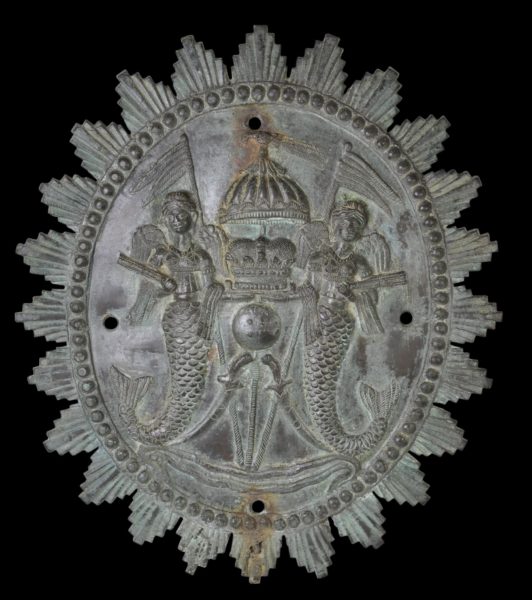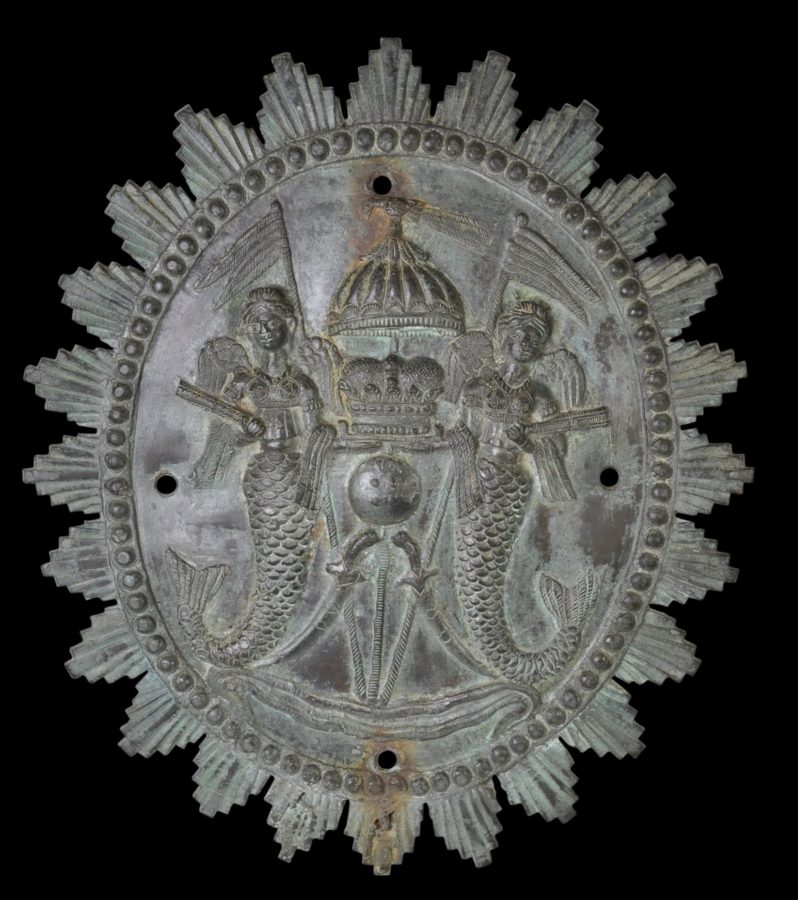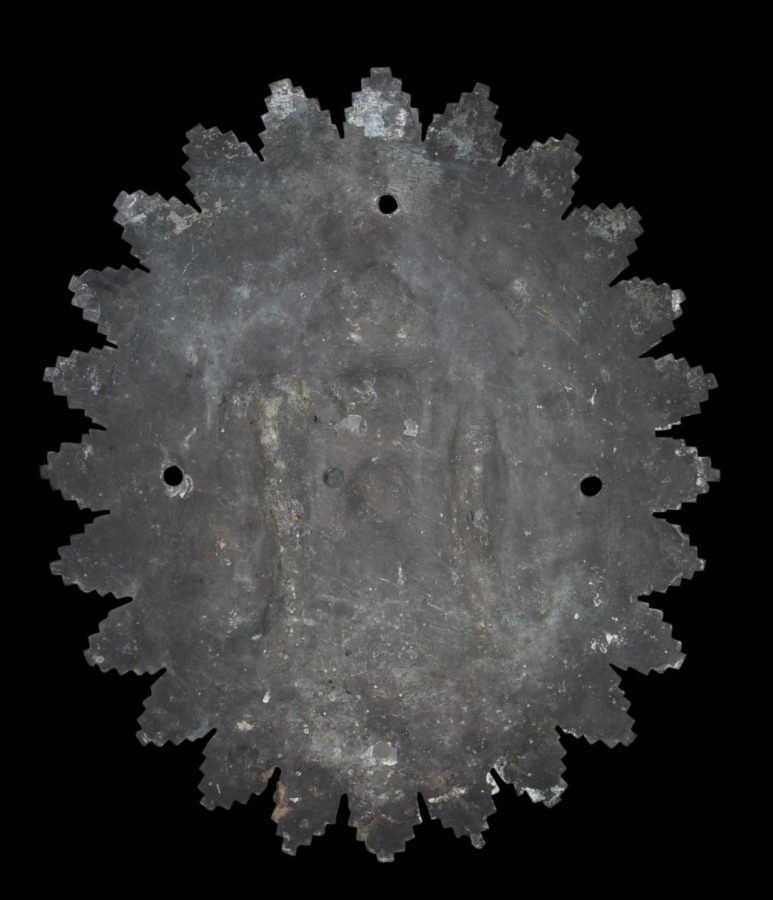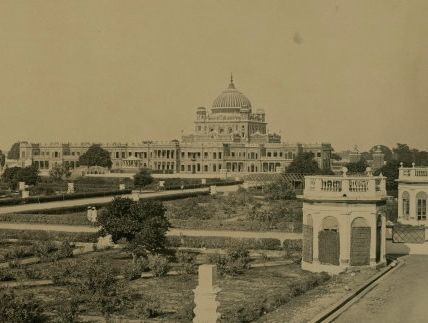This is an extraordinary item.
It is a large bronze plaque cast with the coat of arms of Mohammed Wajid ‘Ali Shah (r. 1847-1856), the last Nawab of Oudh (Awadh), as the rulers of Lucknow and its environs were known. It would have been affixed to a wall in the royal compound or to mark the start of the compound – most probably the Kaiserbagh Palace (also spelt Qaiser Bagh, and shown in the last image below) which was built by Wajid ‘Ali Shah.
It is very likely that the plaque was prised from a wall during the Siege of Lucknow or the fighting in the aftermath, when the British essentially laid waste to imperial quarter of Lucknow. It was at that time that a large quantity of items taken as war booty found their way back to the UK. Many such pieces are now in the the UK’s museums (see for example a throne chair in the Victoria & Albert Museum.)
There were various versions of the Nawabs’ coats or arms, usually they were modified for each new Nawab as he took the throne.
The emblem here, the emblem for Mohammed Wajid ‘Ali Shah, comprises two winged mermaids carrying morchhals (fans) and royal pennons, separated by two swords and a shield with four bosses, over which they hold the royal crown of Oudh above which there is an umbrella surmounted by a bird.
The twin fish (matsya) and the angels (dewa) of past emblems have merged into the winged mermaids of the present example; and the umbrella and bird motif is used as architectural elements on public buildings in Lucknow’s royal quarter to crest domes and finials.
The plaque here is edged with a pearled border and 24 flame-like protuberances which radiate outwards giving the panel a solar nature.
Fish-related motifs were used on royal standards and on the walls, in stucco, of royal compounds. The Nawab even had a floating boat-like vessel shaped as a fish (see Markel et al, 2010, p. 85 for an illustration). And see Markel et al (2010, p. 216) for an image of a goblet chased with the coat of arms of Wajid ‘Ali Shah.
The ruling family of Oudh (Lucknow) established themselves as independent hereditary rulers during the collapse of Mughal power in the early eighteenth century.
The strategic position of their capital and that of Oudh province prompted the British to use them as a buffer state between their own territories in the east, and the west. However the British used the inevitable intrigue and jockeying in the Oudh court to exert greater and greater influence. By the turn of the nineteenth century they managed to virtually exercise a veto right on the succession. The Nawabs devoted much of their time trying to project the outward signs of their sovereignty and regality, rather than exerting real power. Accordingly, Lucknow became an important centre for court arts.
Wajid ‘Ali Shah was the last Nawab of Oudh. By the mid-nineteenth century, the Nawabs had lost their political and military usefulness to the British, and so the British under Dalhousie, Governor General of the East India Company, annexed the kingdom outright in 1856 on the grounds of internal misrule. It was in Oudh where the first great revolt of Indian Independence started in 1857.
The actual siege of Lucknow occurred between 30 May and 27 November 1857. But the British finally retook Lucknow, starting from 6 March 1858 with all fighting over by 21 March 1858.
Meanwhile Wajid ‘Ali Shah was exiled to Calcutta with most of his family. The Siege of Lucknow had its origins in the annexation and the Nawab’s exile. The high-handed action by the East India Company was resented within the state and elsewhere in India.
The plaque here has a varying green and red patina. There are four equidistant holes to allow the plaque to be fixed to a wall. Importantly, the top and bottom holes (and particularly the lower hole and surrounds) show discolouration and deterioration presumably due to rain water flowing down the wall and seeping out via the lower hole. This is consistent with the plaque having been used in situ for a significant period. Other than this, the plaque is stable and in fine condition. It is a superb, historical relic.
References
Bhatt, R., The Life and Times of the Nawabs of Lucknow, Rupa & Co, 2006.
Llewellyn-Jones, R. (ed.), Lucknow: City of Illusion (The Alkazi Collection of Photography), Prestel, 2006.
Markel, S. et al, India’s Fabled City: The Art of Courtly Lucknow, LACMA/DelMonico Books, 2010.
Trivedi, S.D., Masterpieces in the State Museum, Lucknow, 1989.
Varshney, V.P., Lucknow: The City of Heritage & Culture, Niyogi Books, 2017.





